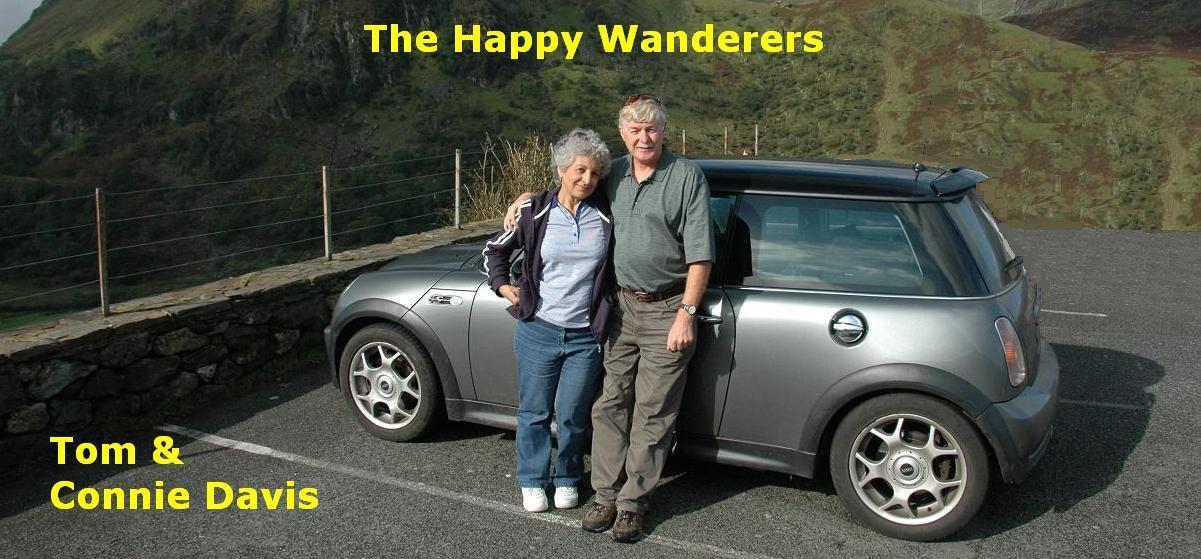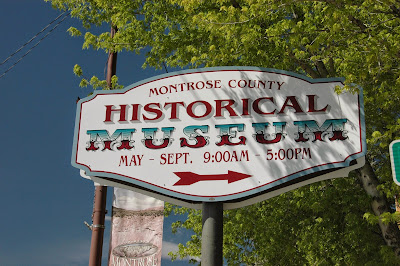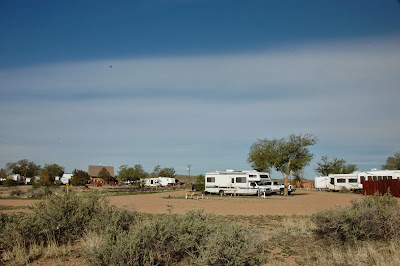We got to Gunnison around noon, so we parked across the street from the museum property, on the edge of a very nice public park, and had a leisurely lunch. After lunch, we dashed across the busy main street of Gunnison, and up to the front door of the museum. There we encountered a large sign which said, "Closed for the Season." "Open May 20th to September 30th." We had missed catching the museum when it was open by a single day. Just a SINGLE DAY!
Last night when we rolled once more into the town of Gunnison, the museum was the very first thing to grab our attention. It was then that we remembered that we had missed it on the previous trip through Colorado. Unfortunately, we did not remember just exactly when the museum opened for the summer.
As I type this account, it is May 17th, 2014. In exactly three days the museum will open again for the summer. THREE DAYS! Now obviously we can't wait around for the next three days for the darn place to open. We just had to move on. But it sure breaks our hearts to have to miss the museum yet again. Guess we're going to have to plan a trip around the museum's schedule so we don't miss it a third time.
Sad but wiser, we turned around and once again headed west on Interstate 50 toward central Utah and home. Fortunately, we did have a couple of other options in towns down the road, so we wouldn't be driving all day, but would be taking the occasional break.
The next major town after Gunnison was Montrose, Colorado, which promised to have not only a sort of frontier museum, but a Ute Indian museum as well. Most of the morning we just motored through the magnificent Rocky Mountains enjoying the snow capped peaks, the wild flower-strewn meadows, and the cold rushing streams beside the highway. Naturally, we had John Denver to keep us company as he belted out his Rocky Mountain songs on the disk player. It was almost heaven!
Dropping out of the Rockies into the lower elevations we came upon Montrose about mid morning. Before long, we had ferreted out the Pioneer Museum and had stowed the rig for a little R&R among the stuff that I love best, things with lots and lots of rust on them. Concetta is not so thrilled with rusty things, but we managed to keep busy trying to identify all the remnants of the past, both inside and outside the museum building. There was farm machinery, printing machinery, ancient laundry day accoutrements, and a whole host of things that on my best day I couldn't identify.
Though not even the museum docent could identify one piece of equipment they had tucked in next to the cowboy cabin, I knew as soon as I walked over to it that I had finally found an antique for which I have been searching for years and years: it was a mule-drawn, ice-cutting plow. What in the heck is that, you say? Well, in the old days when refrigeration was only a pipe dream, nearly everyone in the country needed ice to keep things cool in their "ice boxes." Even today we sometimes call the modern refer an ice box. Most folks don't really know where the ice came from that was delivered to their grandparents' door.
Well, I'll tell you. Most often it came from frozen lakes where ice was cut and stored during the winter for delivery to customers during the summer months. But this ice was far from easy to obtain. If the ice on the local lake was a foot thick during the winter, how in the world did that ice get cut into manageable chunks and eventually get delivered to the hundreds of town ice boxes?
This is where the mule-drawn, ice cutting plow comes into the picture. The plow has a series of sharp blades, mounted all in a row, that can cut down through the ice, going a little deeper with each pass of the mule as he draws it across the frozen lake surface. Mounted about two feet away from, and alongside of, the cutting blades was a similar set of non-cutting blades that could be dropped into the slot just cut in order for the next cut to be equidistant from the first cut. As the mule walked back and forth across the lake, he would finish with a large series of parallel cuts. The cuts did not go all the way through the ice. About a quarter of the ice thickness would remain to support the weight of the mule, plow and other workers.
Once the first set of cuts were finished, then the mule would draw the plow back and forth making cuts at right angles to the first set of cuts. When this was finished, the whole lake had been neatly cut into rectangular or square blocks of ice ready for the men with special hand ice saws to finish cutting each individual block loose from the rest, and floating the blocks over to where the ice house had a conveyer set up. At the conveyer intake, the ice blocks would be moved from lake level, up the conveyer, and finally into the ice house at whatever elevation was required. The conveyer could change it's end-point altitude as the ice house was completely filled at any given level. As each block hit the ice house floor it had to be kept moving until it reached it's individual storage spot. If the ice were to stop moving, even momentarily, it would freeze to the blocks underneath. As you might guess, ice harvesting was not for the faint of heart as the blocks weighed hundreds of pounds each.
Later on the large blocks of ice would be further cut down into manageable pieces for your local ice delivery man to handle. He'd load them in his wagon using a set of ice tongs, carry them to your door using a special leather shoulder pad, and you'd be set for the next few days. In many towns, you would put a special card in your window which told the ice man how much of the frozen stuff you wanted. The card had four triangles printed on the front, each with a different weight of ice desired. Whichever weight was uppermost in your window would signify the amount you wanted delivered.
And there you have it. Up to now, I had never seen an ice plow except in vintage photographs. It was well worth the few bucks entrance fee we paid to visit the museum. Most of the rest of the museum's exhibits and displays were bit dusty and tired, as is the case for many museum facilities nowadays that suffer from lack of funding, lack of interest, or both.
Now that I had MY gem of the day, it was time to go find Concetta's. Concetta had set her sights on the Ute Indian museum on Route 550 on the south side of Montrose. There we hoped to learn a little bit more about the local Native American culture, and hopefully see some of their handiwork. In both these endeavors we were not disappointed. Unlike the Pioneer Museum, the Ute Indian Museum was fresh and modern and extremely well cared for. As we pulled up and parked, We were immediately excited to see that museum was not only an indoor experience, but an outdoor one as well. Flanking the museum building, the tribe had set up a series of teepees that appeared to be period correct in every way.
Naturally, the combination of the white teepees, and the even whiter fluffy clouds against an achingly blue sky made photographing the scene a no-brainer. Even before we set foot in the museum facility itself, we made a bee-line over to the teepees so I could capture the wonderful scene for the blog.
Now, when it comes to the history of the westward expansion, I must admit I've always found the stories of the covered wagons and the settlers far more interesting than the native culture, probably because I actually have an ancestor who was a wagon master on a couple of Mormon trips. But thanks to Concetta, I am gaining a much greater appreciation of the Native American culture.
We spent the first twenty minutes or so in the museum watching a film on the Ute Indian Bear Dance ritual which we both found very interesting. After the film we found our way to the tribal crafts area of the facility. My goodness, some of the leather work and bead work and other art was just way beyond outstanding. I just couldn't get enough of it, and took as many photos as I could.
All too soon our visit to the town of Montrose, Colorado was finished and we had to move on down the road. Just over 65 miles to the west lay the town of Grand Junction, where we are presently encamped at the local KOA. As it turned out, it was well that we motored west when we did. When we arrived in Grand Junction, where unbeknownst to us, several different entertainment venues were in progress, we snagged the very last full-hookup spot in the camp that hadn't already been reserved. Good thing. I would have hated to have my cocktail hour delayed while I searched, probably outside of town, for another suitable campsite.
And that's our day. No plans for tomorrow as yet, but I'm sure there must be something out there in western Colorado or eastern Utah to capture our fancy. Stay tuned. And, if you happen to have one of those mule-drawn, ice-cutting plows languishing in your garage, do give me a call and I'll be happy to take it off your hands.
Ciao for now, and Keep on Traveling!























































